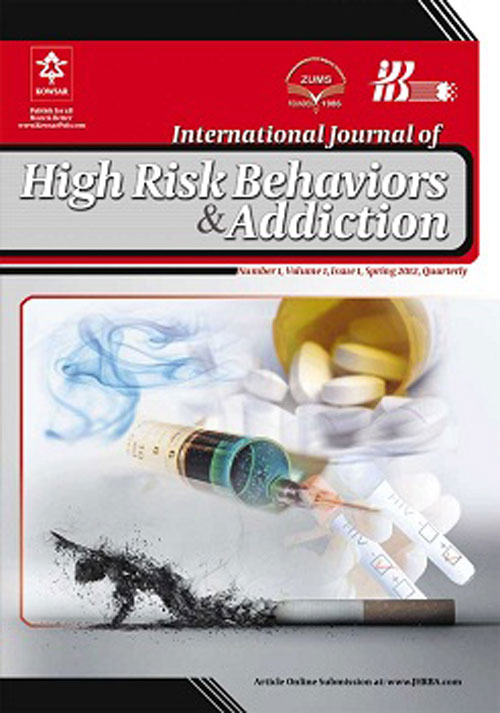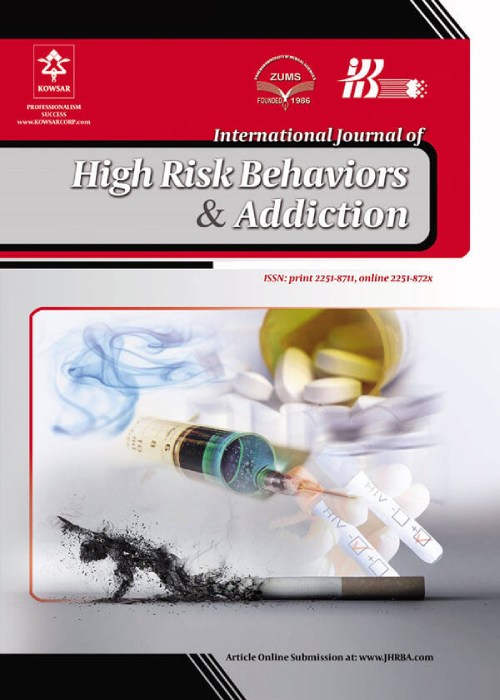فهرست مطالب

International Journal of High Risk Behaviors and Addiction
Volume:7 Issue: 2, Jun 2018
- تاریخ انتشار: 1397/03/30
- تعداد عناوین: 9
-
-
Page 1BackgroundAlthough many risk factors have been proposed for the etiology of the addiction, little research has been conducted from the perspective of evolutionary psychology. The theory of life strategies (with respect to evolutionary causes) has led to a new understanding of addiction. While researchers have shown that Cloningers bio-psychological model is one of the most important personality factors in the etiology of addiction, there is no research about the relationship between life strategy and the temperament-character component of addiction.ObjectivesThe main objective of this study was to examine the relationship between these two variables in individuals with opioid use disorder in comparison with the normal group.
Patients andMethodsThis correlational study included 96 participants with opioid use disorder selected by convenience sampling from the Iranian national center for addiction studies (INCAS) and 97 participants without any substance use disorder, who were matched to the opioid-use group. After administering the mini-form of Arizona life history battery (ALHB) and the temperament and character inventory (TCI), data were analyzed with Pearsons correlation coefficient and multivariate regression.ResultsResults showed a relationship between fast-life strategy and novelty seeking in the group with opioid use disorder and a positive relationship between slow-life strategy and co-operation in the control group. The regression analysis indicated that novelty seeking was able to predict fast-life strategy in the opioid use group and co-operation could predict slow-life strategy in the control group.ConclusionsLife strategy could be a new variable in understanding and planning addiction prevention programs.Keywords: Substance-Related Disorders, Life History Traits, Temperament, Character -
Page 2BackgroundTobacco use is one of the major preventable causes of death in the world and is one of the most prevalent public health problems in Iran. Cigarette cravings are influenced by various psycho-social factors.ObjectivesThis study aimed to investigate craving a cigarette based on perceived criticism by parents, dose of usage, and emotional self-regulation in adolescents.
Patients andMethodsThis study was performed as a cross-sectional self-reported questionnaire and structural equation modeling. A sample of 350 male students were randomly selected from different high schools in Isfahan. Three questionnaires including Hooked on Nicotine Checklist (HONC), emotion regulation inventory, and Perceived Criticism Measure (PCM) were employed. Data were analyzed using the Chi-square, correlation coefficient, and structural modeling tests.ResultsThe results of this study showed that 34.4% of students had experienced smoking more than 20 cigarettes throughout their lifetime. There was a significant correlation between emotional reappraisal (r =- 0.48), expressive suppression (r = -0.58), and perceived criticism (r = 0.56) with cigarette cravings (PConclusionsIn total, the results of this study revealed that high levels of smoking tendency in students is a crucial issue; therefore, students psychological problems such as negative experiences is associated with criticism by parents, adaptive emotion-regulation strategies, and prevention of smoking. Cautions regarding adverse health and social consequences of smoking to students should be taken into consideration by authorities and families.Keywords: Criticism, Emotion, Regulation, Smoking -
Page 3BackgroundAlthough the importance of sex education for the youth is well documented in the literature around the world, sex education remains controversial in Iran.ObjectivesThe aim of this study was to explore Iranian womens beliefs and perceptions regarding advantages and disadvantages of sex education.
Patients andMethodsIn this qualitative inquiry, we interviewed 41 young women aged 18 - 35. Focus group discussions and individual interviews were used to collect the data. Conventional content analysis was used for data analysis. Multiple data collection methods, maximum variation sampling, and peer checks were applied to empower the rigor of study.ResultsA total of 5 themes were categorized into 2 main domains: advantages and disadvantage of sex education. The first domain was conceptualized by increased knowledge, normalization of sexual and reproductive issues, and self-efficacy; the later domain by: motives for initiating sexual behavior and tainted modesty.ConclusionsSince most young women believed that sex education is beneficial for them, an effective, appropriate, and culturally-approved program could be designed for sex education.Keywords: Sex Education, Advantage, Disadvantage -
Page 4BackgroundBuprenorphine is usually administered to manage opioid use disorder and pain syndromes. It could be a proper treatment option for suicidality, resistant depression, self-destructive behavior, and anxiety. Buprenorphine has a considerable abuse potential that confines its administration in patients committing suicide with a background of substance abuse.ObjectivesThe current study aimed to clarify the influence of different doses of buprenorphine on opioid-dependent patients committing suicide over a 2-day period in a randomized, clinical trial (RCT).
Patients andMethodsPatients were randomly assigned into 3 groups. Twenty-three suicidal male patients who met the DSM-5 (diagnostic and statistical manual of mental disorders) criteria for opioid dependence and sought treatment were recruited. Patients randomly received 32, 64, or 96 mg of buprenorphine as a single high-dose only and were hospitalized in a psychiatric inpatient ward. Out of the 23 patients, 9 (39.2%), 8 (34.8%), and 6 (26%) received 32, 64, and 96 mg of buprenorphine, respectively. Psychometric assessment was performed using the Beck scale for suicidal ideation (BSSI) and interview. All patients completed the 2-day treatment period. The results indicated a significant decrease in BSSI scores in each of the 3 groups (PConclusionsThe current study results indicated that a single high-dose of buprenorphine could provide a speedy and safe means to treat suicidality in opioid-dependent patients.Keywords: Buprenorphine, Depressive Disorder-Major, Suicide, Opioid -
Page 5BackgroundPrevalence of hepatitis B has been significantly increased among injecting drug users (IDUs) in the recent years.ObjectivesThe purpose of the present study was to investigate the effect of health belief model (HBM)-based training on the preventive behaviors of hepatitis B in addicts.
Patients andMethodsIn this quasi-experimental study, 84 eligible substance users were selected and randomly assigned to experimental and control groups. Data were gathered using 3 questionnaires: demographics, HBMs components, and the preventive behavior of hepatitis B. A HBM-based intervention was conducted on the experimental group. The data were analyzed by paired and independent t-tests, analysis of covariance (ANCOVA), and Chi-square test using the SPSS/16 software.ResultsA significant difference was observed between the means of all HBMs components and preventive behaviors of hepatitis B of the 2 groups except perceived severity after the intervention (PConclusionsTraining based on HBM could have effects on the preventive behaviors of hepatitis B. Training based on HMB is recommended as a low-cost and effective method.Keywords: Health Education, Behavior, Hepatitis B, Substance Abuse -
Page 6BackgroundThere are limited available scientific sources of data and rare controlled studies to guide the anesthesiologist regarding preoperative analgesic care in opioid addict patients, despite the increasing prevalence of opioid dependency.ObjectivesIn the present study, we aimed to evaluate the effect of using Dexmedetomidine (Dex) during femoral neck surgery on the postoperative analgesic consumption in opium addict patients.
Patients andMethodsThe present study is a double-blind randomized clinical trial. Patients suffering from femoral neck fracture with a history of opium addiction who were candidates for surgery under spinal anesthesia were included. After induction of spinal anesthesia using hyperbaric bupivacaine, either Dex or normal saline was infused for patients. Dex with a dose of 0.5 µg/kg/h in the intervention group and normal saline with a dose of 0.5 cc/kg/h in the control group was administered. After the surgery, pain intensity of the patients in recovery was assessed in 10-minute intervals based on visual analog scale (VAS) until 2 hours postoperatively. Time to pain and the total amount of opium consumption for pain control in 24 hours postoperatively were calculated and compared between the 2 groups.ResultsFinally, 25 patients in each group were studied. Demographic and baseline characteristics of the patients in the 2 groups were not significantly different. Mean morphine consumption in recovery until 2 hours postoperatively showed no significant difference between Dex and control groups (P = 0.24). However, the mean opioid use during 24 hours postoperatively was significantly difference and it was lower in the group receiving Dex infusion (PConclusionsIt is likely that intravenous Dex infusion during femoral neck fracture surgery under spinal anesthesia can lead to the less opioid use throughout the 24 hours postoperatively in opium addict patients.Keywords: Femoral Neck Fractures, Anesthesia, Spinal, Dexmedetomidine, Pain Management, Drug Users -
Page 7BackgroundPsychotic disorder due to methamphetamine has a high prevalence with an unknown nature and history. Patients with such disorders are faced with the risk of recurrence of abuse and other psychiatric disorders. Methamphetamine-induced psychotic disorders may continue by independent of methamphetamine abuse, such as primary psychotic disorders (such as schizophrenia).ObjectivesThis study was performed to evaluate the mental health and frequency of methamphetamine-induced psychosis in patients referred to Iran psychiatric hospital (a university hospital in Tehran, Iran).
Patients andMethodsThe research was done on patients with methamphetamine-induced psychosis after 2 to 5 years using of methamphetamine (150 person in the Iran Psychiatric Hospital) .The diagnostic interview was done based on a semi-structured interview (SCID). The data was analyzed by Binary Logistic Regression Model.ResultsFrom 150 patients that were followed, 6 of them (4.0%) died during the phone interview-follow up. The mean age of alive patients was 34.9 ± 8.7 years and 12 of them were women (8.0%). At the follow-up interview, 38 patients reclassified as the cases of schizophrenia (25.3%), 17 as the cases of major depressive disorder (11.3%), 7 as the cases of bipolar disorder type I (4.7), two as the cases of schizoaffective disorder (1.3%), and two of them as the cases of delusional disorder (1.3%). A total of 84 cases (56.0%) were diagnosed as recovered cases or as methamphetamine-induced psychotic disorders. Prediction of diagnosis change showed the diagnosis of methamphetamine use disorder (adjusted OR = 3.978, 95% CI: 1.265 - 12.512), previous psychiatric admission (adjusted OR = 6.749; 95% CI: 1.639 - 27.779), and short duration of psychotic episode (adjusted OR = 0.171; 95% CI: 0.056 - 0.520.ConclusionsThe results of our study show that methamphetamine-induced psychotic disorders are associated, in many cases, with the mood disorders. It seems that comorbid mood disorders, age of first use, history of previous psychiatric hospitalization, the risk of methamphetamine use disorders, and psychotic episodes are associated longer with the diagnosis towards primary psychotic disorders.Keywords: Methamphetamine, Psychotic Disorders, Substance-Related Disorders -
Page 8BackgroundLiterature documents the high prevalence of trauma and posttraumatic stress disorder (OTSD) in individuals with substance use disorders, which complicate the clinical profile of patients and present challenges for treatment providers. Although several evidence-based integrated therapies are developed for comorbid PTSD/SUD (substance use disorder), there is a considerable gap addressing this co-occurrence and none of such practices are studied yet on such patients. Through A-B-A single subject design.ObjectivesThe current study aimed to explore the effectiveness of seeking safety (SS), an integrative evidence-based therapy for PTSD/SUD, to reduce PTSD and SUD symptoms in a 32-year-old female with both disorders.
Patients andMethodsMeasures of PTSD checklist (PTSD Checklist_Civilian; PCL-C), Addiction Severity Index (ASI), Brief Symptom Inventory (BSI), and Coping Inventory for Stressful Situations (CISS-21) were completed by the participant at baseline, intervention, and 2-month follow-up.ResultsResults were analyzed through visual analysis and computing 3 effect size indices including standardized mean difference (SMD), mean baseline reduction (MBLR), and percent of non-overlapping data (PND).ConclusionsClinically significant reductions in PTSD symptoms, psychological distress, and ASI scores, as well as improvement in coping skills were observed at intervention phase and maintained at 2-month follow-up, which indicated that the participant benefited from SS.Keywords: Comorbidity, Substance Use Disorder, Posttraumatic Stress Disorder


